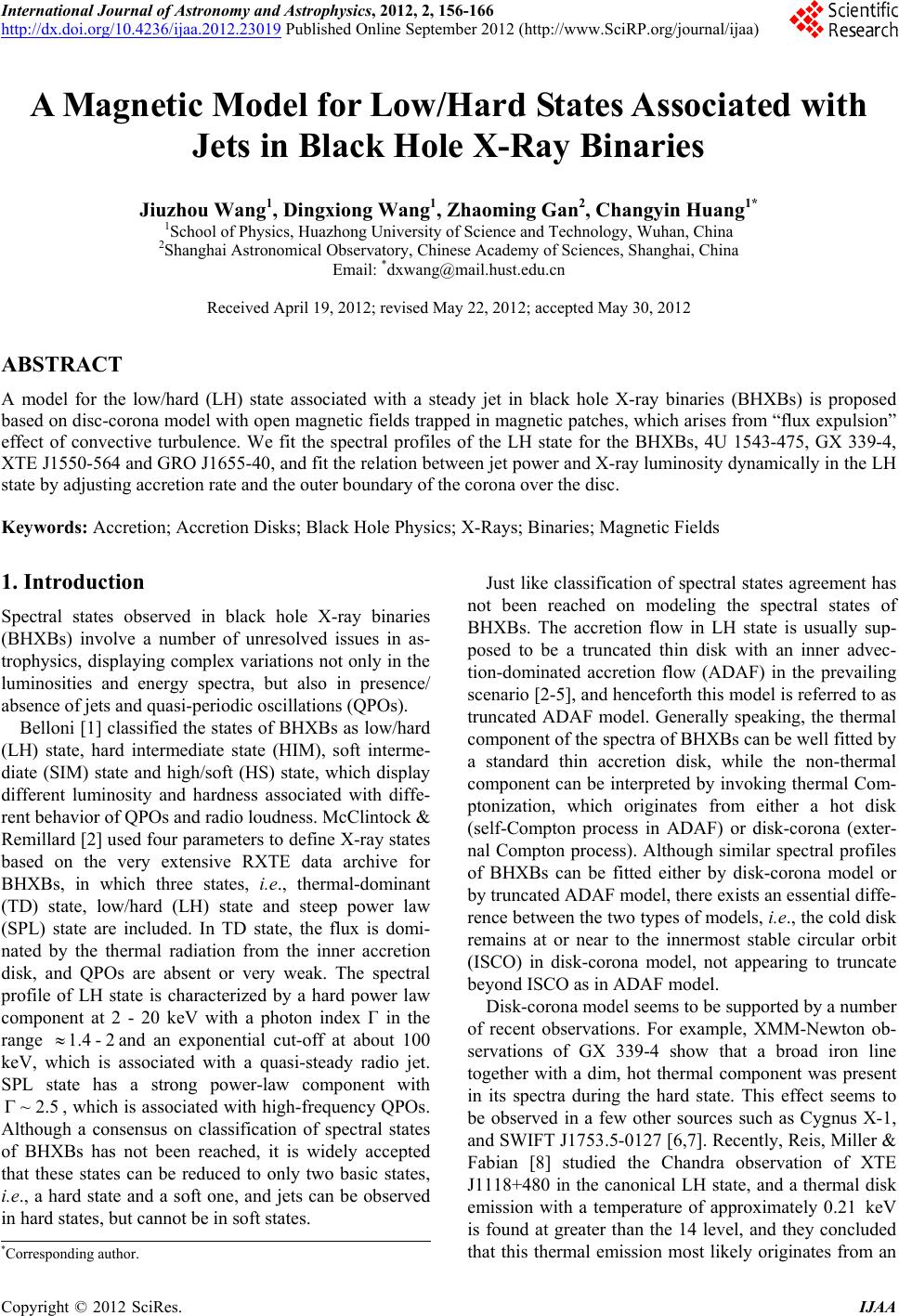 International Journal of Astronomy and Astrophysics, 2012, 2, 156-166 http://dx.doi.org/10.4236/ijaa.2012.23019 Published Online September 2012 (http://www.SciRP.org/journal/ijaa) A Magnetic Model for Low/Hard States Associated with Jets in Black Hole X-Ray Binaries Jiuzhou Wang1, Dingxiong Wang1, Zhaoming Gan2, Changyin Huang1* 1School of Physics, Huazhong University of Science and Technology, Wuhan, China 2Shanghai Astronomical Observatory, Chinese Academy of Sciences, Shanghai, China Email: *dxwang@mail.hust.edu.cn Received April 19, 2012; revised May 22, 2012; accepted May 30, 2012 ABSTRACT A model for the low/hard (LH) state associated with a steady jet in black hole X-ray binaries (BHXBs) is proposed based on disc-corona model with open magnetic fields trapped in magnetic patches, which arises from “flux expulsion” effect of convective turbulence. We fit the spectral profiles of the LH state for the BHXBs, 4U 1543-475, GX 339-4, XTE J1550-564 and GRO J1655-40, and fit the relation between jet power and X-ray luminosity dynamically in the LH state by adjusting accretion rate and the outer boundary of the corona over the disc. Keywords: Accretion; Accretion Disks; Black Hole Physics; X-Rays; Binaries; Magnetic Fields 1. Introduction Spectral states observed in black hole X-ray binaries (BHXBs) involve a number of unresolved issues in as- trophysics, displaying complex variations not only in the luminosities and energy spectra, but also in presence/ absence of jets and quasi-periodic oscillations (QPOs). Belloni [1] classified the states of BHXBs as low/hard (LH) state, hard intermediate state (HIM), soft interme- diate (SIM) state and high/soft (HS) state, which display different luminosity and hardness associated with diffe- rent behavior of QPOs and radio loudness. McClintock & Remillard [2] used four parameters to define X-ray states based on the very extensive RXTE data archive for BHXBs, in which three states, i.e., thermal-dominant (TD) state, low/hard (LH) state and steep power law (SPL) state are included. In TD state, the flux is domi- nated by the thermal radiation from the inner accretion disk, and QPOs are absent or very weak. The spectral profile of LH state is characterized by a hard power law component at 2 - 20 keV with a photon index Γ in the range and an exponential cut-off at about 100 keV, which is associated with a quasi-steady radio jet. SPL state has a strong power-law component with , which is associated with high-frequency QPOs. Although a consensus on classification of spectral states of BHXBs has not been reached, it is widely accepted that these states can be reduced to only two basic states, i.e., a hard state and a soft one, and jets can be observed in hard states, but cannot be in soft states. 1.4 - 2 .5~2 Just like classification of spectral states agreement has not been reached on modeling the spectral states of BHXBs. The accretion flow in LH state is usually sup- posed to be a truncated thin disk with an inner advec- tion-dominated accretion flow (ADAF) in the prevailing scenario [2-5], and henceforth this model is referred to as truncated ADAF model. Generally speaking, the thermal component of the spectra of BHXBs can be well fitted by a standard thin accretion disk, while the non-thermal component can be interpreted by invoking thermal Com- ptonization, which originates from either a hot disk (self-Compton process in ADAF) or disk-corona (exter- nal Compton process). Although similar spectral profiles of BHXBs can be fitted either by disk-corona model or by truncated ADAF model, there exists an essential diffe- rence between the two types of models, i.e., the cold disk remains at or near to the innermost stable circular orbit (ISCO) in disk-corona model, not appearing to truncate beyond ISCO as in ADAF model. Disk-corona model seems to be supported by a number of recent observations. For example, XMM-Newton ob- servations of GX 339-4 show that a broad iron line together with a dim, hot thermal component was present in its spectra during the hard state. This effect seems to be observed in a few other sources such as Cygnus X-1, and SWIFT J1753.5-0127 [6,7]. Recently, Reis, Miller & Fabian [8] studied the Chandra observation of XTE J1118+480 in the canonical LH state, and a thermal disk emission with a temperature of approximately 0.21 keV is found at greater than the 14 level, and they concluded that this thermal emission most likely originates from an *Corresponding author. C opyright © 2012 SciRes. IJAA 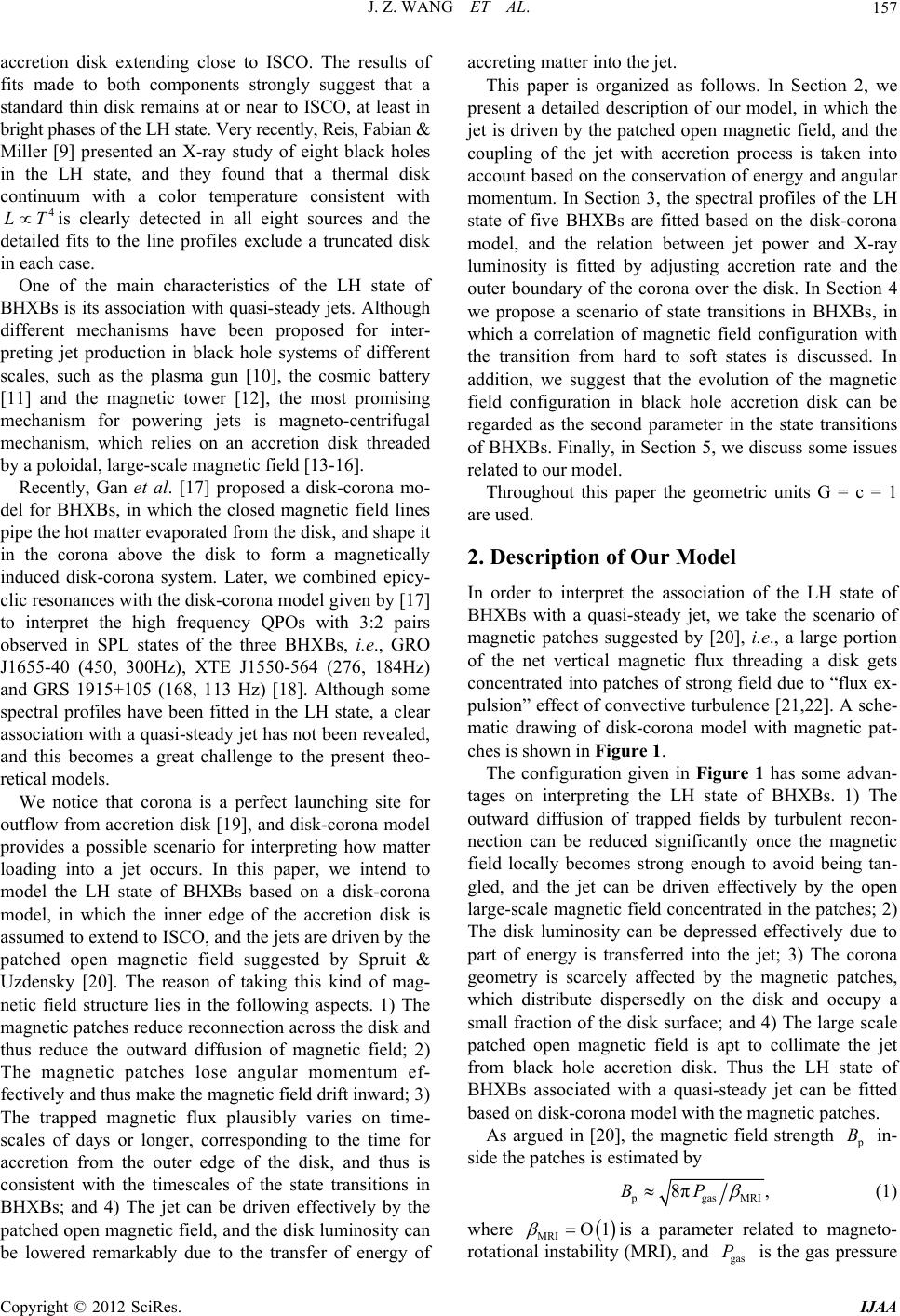 J. Z. WANG ET AL. 157 accretion disk extending close to ISCO. The results of fits made to both components strongly suggest that a standard thin disk remains at or near to ISCO, at least in bright phases of the LH state. Very recently, Reis, Fabian & Miller [9] presented an X-ray study of eight black holes in the LH state, and they found that a thermal disk continuum with a color temperature consistent with is clearly detected in all eight sources and the detailed fits to the line profiles exclude a truncated disk in each case. 4 LT One of the main characteristics of the LH state of BHXBs is its association with quasi-steady jets. Although different mechanisms have been proposed for inter- preting jet production in black hole systems of different scales, such as the plasma gun [10], the cosmic battery [11] and the magnetic tower [12], the most promising mechanism for powering jets is magneto-centrifugal mechanism, which relies on an accretion disk threaded by a poloidal, large-scale magnetic field [13-16]. Recently, Gan et al. [17] proposed a disk-corona mo- del for BHXBs, in which the closed magnetic field lines pipe the hot matter evaporated from the disk, and shape it in the corona above the disk to form a magnetically induced disk-corona system. Later, we combined epicy- clic resonances with the disk-corona model given by [17] to interpret the high frequency QPOs with 3:2 pairs observed in SPL states of the three BHXBs, i.e., GRO J1655-40 (450, 300Hz), XTE J1550-564 (276, 184Hz) and GRS 1915+105 (168, 113 Hz) [18]. Although some spectral profiles have been fitted in the LH state, a clear association with a quasi-steady jet has not been revealed, and this becomes a great challenge to the present theo- retical models. We notice that corona is a perfect launching site for outflow from accretion disk [19], and disk-corona model provides a possible scenario for interpreting how matter loading into a jet occurs. In this paper, we intend to model the LH state of BHXBs based on a disk-corona model, in which the inner edge of the accretion disk is assumed to extend to ISCO, and the jets are driven by the patched open magnetic field suggested by Spruit & Uzdensky [20]. The reason of taking this kind of mag- netic field structure lies in the following aspects. 1) The magnetic patches reduce reconnection across the disk and thus reduce the outward diffusion of magnetic field; 2) The magnetic patches lose angular momentum ef- fectively and thus make the magnetic field drift inward; 3) The trapped magnetic flux plausibly varies on time- scales of days or longer, corresponding to the time for accretion from the outer edge of the disk, and thus is consistent with the timescales of the state transitions in BHXBs; and 4) The jet can be driven effectively by the patched open magnetic field, and the disk luminosity can be lowered remarkably due to the transfer of energy of accreting matter into the jet. This paper is organized as follows. In Section 2, we present a detailed description of our model, in which the jet is driven by the patched open magnetic field, and the coupling of the jet with accretion process is taken into account based on the conservation of energy and angular momentum. In Section 3, the spectral profiles of the LH state of five BHXBs are fitted based on the disk-corona model, and the relation between jet power and X-ray luminosity is fitted by adjusting accretion rate and the outer boundary of the corona over the disk. In Section 4 we propose a scenario of state transitions in BHXBs, in which a correlation of magnetic field configuration with the transition from hard to soft states is discussed. In addition, we suggest that the evolution of the magnetic field configuration in black hole accretion disk can be regarded as the second parameter in the state transitions of BHXBs. Finally, in Section 5, we discuss some issues related to our model. Throughout this paper the geometric units G = c = 1 are used. 2. Description of Our Model In order to interpret the association of the LH state of BHXBs with a quasi-steady jet, we take the scenario of magnetic patches suggested by [20], i.e., a large portion of the net vertical magnetic flux threading a disk gets concentrated into patches of strong field due to “flux ex- pulsion” effect of convective turbulence [21,22]. A sche- matic drawing of disk-corona model with magnetic pat- ches is shown in Figure 1. The configuration given in Figure 1 has some advan- tages on interpreting the LH state of BHXBs. 1) The outward diffusion of trapped fields by turbulent recon- nection can be reduced significantly once the magnetic field locally becomes strong enough to avoid being tan- gled, and the jet can be driven effectively by the open large-scale magnetic field concentrated in the patches; 2) The disk luminosity can be depressed effectively due to part of energy is transferred into the jet; 3) The corona geometry is scarcely affected by the magnetic patches, which distribute dispersedly on the disk and occupy a small fraction of the disk surface; and 4) The large scale patched open magnetic field is apt to collimate the jet from black hole accretion disk. Thus the LH state of BHXBs associated with a quasi-steady jet can be fitted based on disk-corona model with the magnetic patches. As argued in [20], the magnetic field strength B in- side the patches is estimated by gas MRI 8π,BP (1) where MRI O1 is a parameter related to magneto- rotational instability (MRI), and is the gas pressure gas P Copyright © 2012 SciRes. IJAA 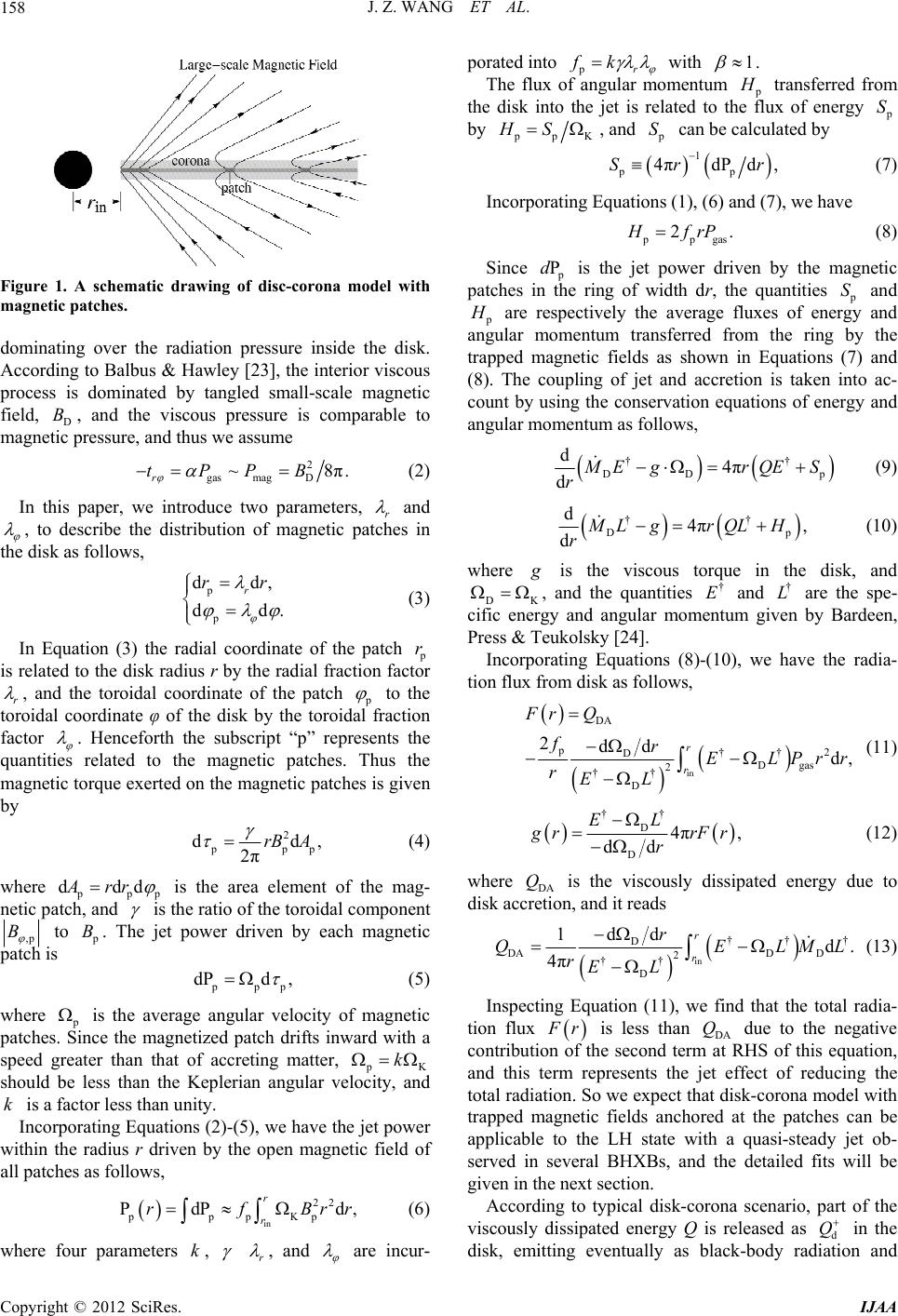 J. Z. WANG ET AL. 158 Figure 1. A schematic drawing of disc-corona model with magnetic patches. dominating over the radiation pressure inside the disk. According to Balbus & Hawley [23], the interior viscous process is dominated by tangled small-scale magnetic field, D, and the viscous pressure is comparable to magnetic pressure, and thus we assume B 2 gas magD ~π. r tPPB 8 (2) In this paper, we introduce two parameters, r and , to describe the distribution of magnetic patches in the disk as follows, p p dd dd r rr , . (3) In Equation (3) the radial coordinate of the patch r is related to the disk radius r by the radial fraction factor r , and the toroidal coordinate of the patch to the toroidal coordinate φ of the disk by the toroidal fraction factor . Henceforth the subscript “p” represents the quantities related to the magnetic patches. Thus the magnetic torque exerted on the magnetic patches is given by 2 pp d 2πrB A d, (4) where pp dddArr is the area element of the mag- netic patch, and is the ratio of the toroidal component ,p B to B. The jet power driven by each magnetic patch is pp dPd , (5) where is the average angular velocity of magnetic patches. Since the magnetized patch drifts inward with a speed greater than that of accreting matter, K should be less than the Keplerian angular velocity, and is a factor less than unity. k k Incorporating Equations (2)-(5), we have the jet power within the radius r driven by the open magnetic field of all patches as follows, in 22 pppKp PdP r r rfBr d,r (6) where four parameters , k r , and are incur- porated into pr fk with 1 . The flux of angular momentum transferred from the disk into the jet is related to the flux of energy S by pK HS , and S can be calculated by 1 pp πdP d,Sr r 4 (7) Incorporating Equations (1), (6) and (7), we have pgas 2. frP (8) Since Pd is the jet power driven by the magnetic patches in the ring of width dr, the quantities S and are respectively the average fluxes of energy and angular momentum transferred from the ring by the trapped magnetic fields as shown in Equations (7) and (8). The coupling of jet and accretion is taken into ac- count by using the conservation equations of energy and angular momentum as follows, † DD p 4π † d d Eg r rQES (9) † d dML g r † Dp 4π, rQL H (10) where is the viscous torque in the disk, and DK , and the quantities and are the spe- cific energy and angular momentum given by Bardeen, Press & Teukolsky [24]. † E† L Incorporating Equations (8)-(10), we have the radia- tion flux from disk as follows, in ††2 Dg as 2 2d, r r Fr fELPrr r DA pD †† D dd Q r EL (11) †† D D 4π, dd EL r r rFr (12) where DA is the viscously dissipated energy due to disk accretion, and it reads Q in ††† D DAD D 2 †† D dd 1d. 4π r r r QE rEL LML (13) Inspecting Equation (11), we find that the total radia- tion flux r is less than DA due to the negative contribution of the second term at RHS of this equation, and this term represents the jet effect of reducing the total radiation. So we expect that disk-corona model with trapped magnetic fields anchored at the patches can be applicable to the LH state with a quasi-steady jet ob- served in several BHXBs, and the detailed fits will be given in the next section. Q According to typical disk-corona scenario, part of the viscously dissipated energy Q is released as d Q in the disk, emitting eventually as black-body radiation and Copyright © 2012 SciRes. IJAA 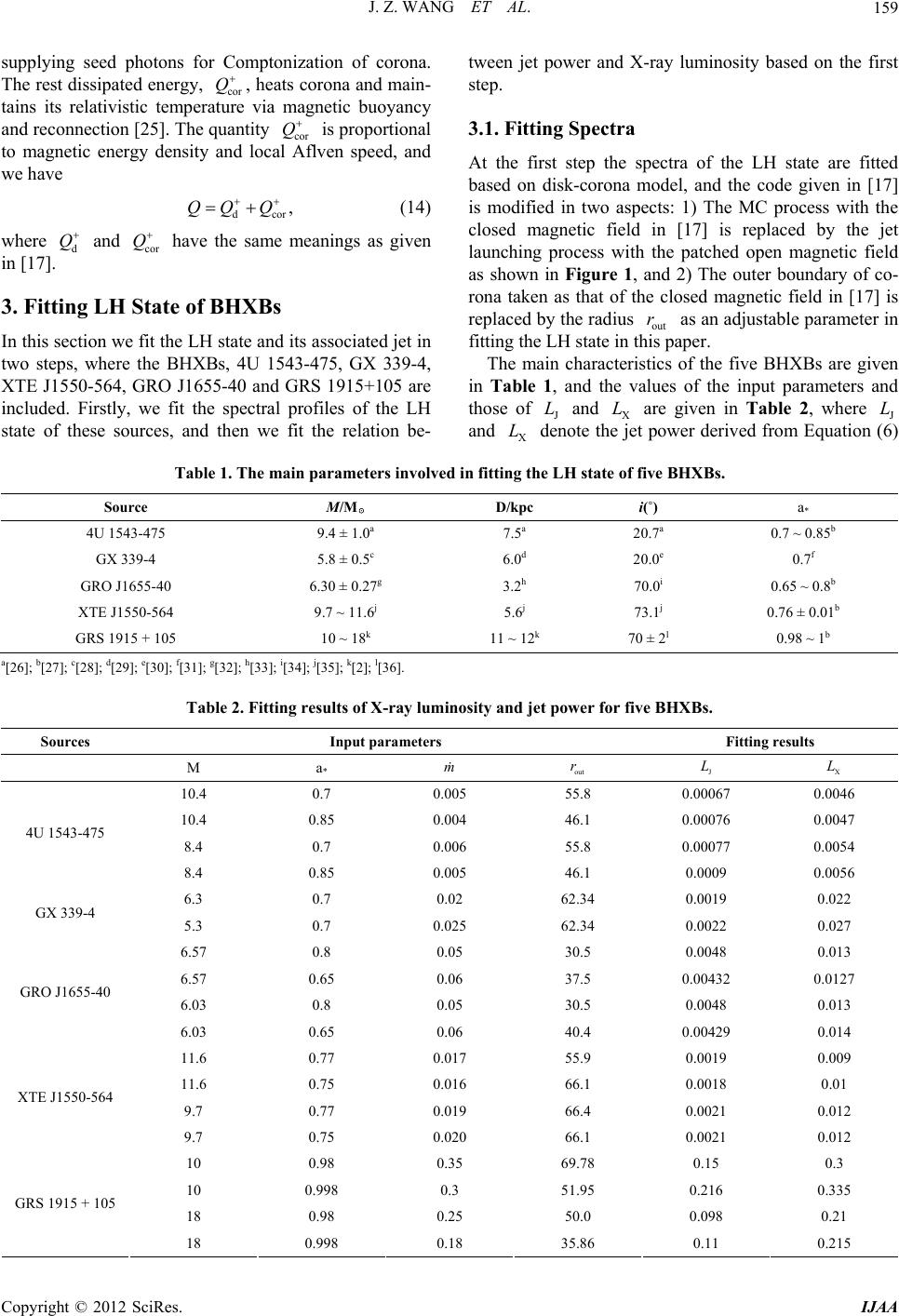 J. Z. WANG ET AL. Copyright © 2012 SciRes. IJAA 159 tween jet power and X-ray luminosity based on the first step. supplying seed photons for Comptonization of corona. The rest dissipated energy, cor Q , heats corona and main- tains its relativistic temperature via magnetic buoyancy and reconnection [25]. The quantity cor is proportional to magnetic energy density and local Aflven speed, and we have Q cor ,Q 3.1. Fitting Spectra At the first step the spectra of the LH state are fitted based on disk-corona model, and the code given in [17] is modified in two aspects: 1) The MC process with the closed magnetic field in [17] is replaced by the jet launching process with the patched open magnetic field as shown in Figure 1, and 2) The outer boundary of co- rona taken as that of the closed magnetic field in [17] is replaced by the radius out as an adjustable parameter in fitting the LH state in this paper. r d QQ (14) where and have the same meanings as given in [17]. d Q cor Q 3. Fitting LH State of BHXBs In this section we fit the LH state and its associated jet in two steps, where the BHXBs, 4U 1543-475, GX 339-4, XTE J1550-564, GRO J1655-40 and GRS 1915+105 are included. Firstly, we fit the spectral profiles of the LH state of these sources, and then we fit the relation be- The main characteristics of the five BHXBs are given in Table 1, and the values of the input parameters and those of J and X are given in Table 2, where J and denote the jet power derived from Equation (6) L LL X L Table 1. The main parameters involved in fitting the LH state of five BHXBs. Source M/M☉ D/kpc i(˚) * a 4U 1543-475 9.4 ± 1.0a 7.5a 20.7a 0.7 ~ 0.85b GX 339-4 5.8 ± 0.5c 6.0d 20.0e 0.7f GRO J1655-40 6.30 ± 0.27g 3.2h 70.0i 0.65 ~ 0.8b XTE J1550-564 9.7 ~ 11.6j 5.6j 73.1j 0.76 ± 0.01b GRS 1915 + 105 10 ~ 18k 11 ~ 12k 70 ± 2l 0.98 ~ 1b a[26]; b[27]; c[28]; d[29]; e[30]; f[31]; g[32]; h[33]; i[34]; j[35]; k[2]; l[36]. Table 2. Fitting results of X-ray luminosity and jet power for five BHXBs. Sources Input parameters Fitting results M a* m out r J X 10.4 0.7 0.005 55.8 0.00067 0.0046 10.4 0.85 0.004 46.1 0.00076 0.0047 8.4 0.7 0.006 55.8 0.00077 0.0054 4U 1543-475 8.4 0.85 0.005 46.1 0.0009 0.0056 6.3 0.7 0.02 62.34 0.0019 0.022 GX 339-4 5.3 0.7 0.025 62.34 0.0022 0.027 6.57 0.8 0.05 30.5 0.0048 0.013 6.57 0.65 0.06 37.5 0.00432 0.0127 6.03 0.8 0.05 30.5 0.0048 0.013 GRO J1655-40 6.03 0.65 0.06 40.4 0.00429 0.014 11.6 0.77 0.017 55.9 0.0019 0.009 11.6 0.75 0.016 66.1 0.0018 0.01 9.7 0.77 0.019 66.4 0.0021 0.012 XTE J1550-564 9.7 0.75 0.020 66.1 0.0021 0.012 10 0.98 0.35 69.78 0.15 0.3 10 0.998 0.3 51.95 0.216 0.335 18 0.98 0.25 50.0 0.098 0.21 GRS 1915 + 105 18 0.998 0.18 35.86 0.11 0.215 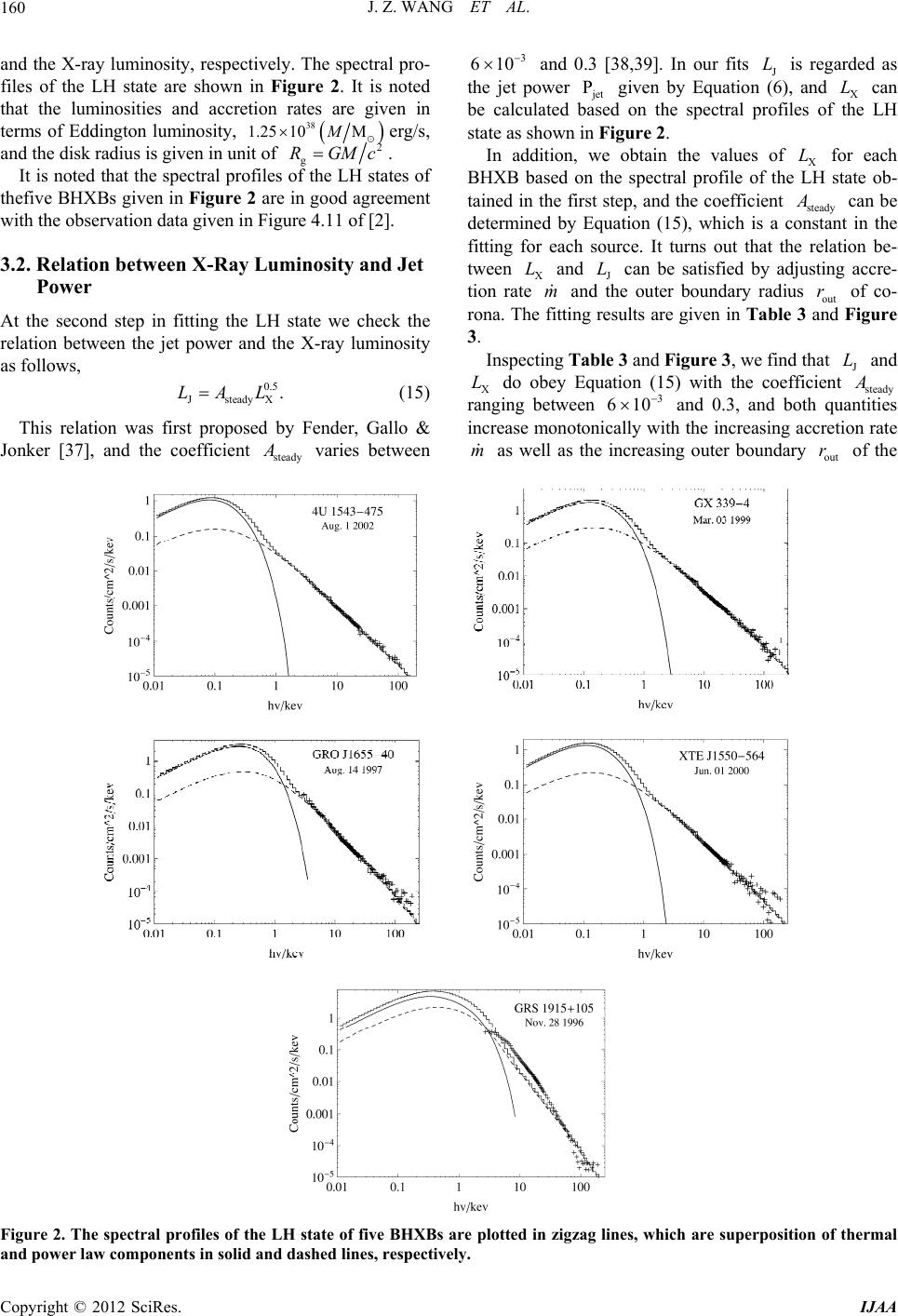 J. Z. WANG ET AL. 160 and the X-ray luminosity, respectively. The spectral pro- files of the LH state are shown in Figure 2. It is noted that the luminosities and accretion rates are given in terms of Eddington luminosity, 38 1.25 10MMerg/s, and the disk radius is given in unit of 2 g RGMc. It is noted that the spectral profiles of the LH states of thefive BHXBs given in Figure 2 are in good agreement with the observation data given in Figure 4.11 of [2]. 3.2. Relation between X-Ray Luminosity and Jet Power At the second step in fitting the LH state we check the relation between the jet power and the X-ray luminosity as follows, 0.5 JsteadyX .LAL (15) This relation was first proposed by Fender, Gallo & Jonker [37], and the coefficient varies between steady A 3 610 and 0.3 [38,39]. In our fits J is regarded as the jet power jet given by Equation (6), and X can be calculated based on the spectral profiles of the LH state as shown in Figure 2. L PL In addition, we obtain the values of X for each BHXB based on the spectral profile of the LH state ob- tained in the first step, and the coefficient steady can be determined by Equation (15), which is a constant in the fitting for each source. It turns out that the relation be- tween X and J can be satisfied by adjusting accre- tion rate and the outer boundary radius out of co- rona. The fitting results are given in Table 3 and Figure 3. L A r L m L Inspecting Tabl e 3 and Figure 3 , we find that and X do obey Equation (15) with the coefficient steady ranging between J L AL 3 610 and 0.3, and both quantities increase monotonically with the increasing accretion rate as well as the increasing outer boundary of the m out r Figure 2. The spectral profiles of the LH state of five BHXBs are plotted in zigzag lines, which are superposition of thermal and power law components in solid and dashed lines, respectively. Copyright © 2012 SciRes. IJAA 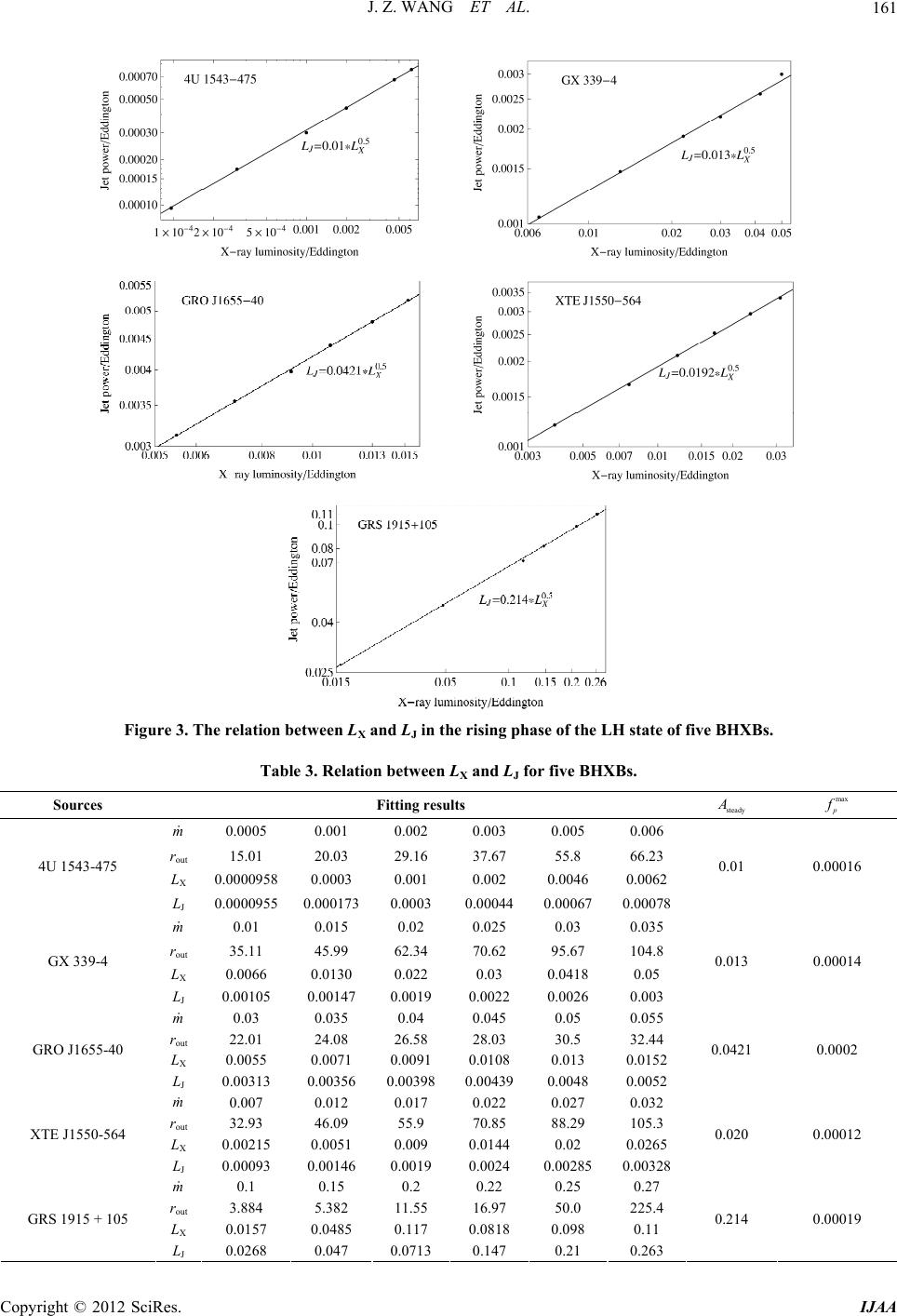 J. Z. WANG ET AL. 161 Figure 3. The relation between LX and LJ in the rising phase of the LH state of five BHXBs. Table 3. Relation betw ee n LX and LJ for five BHXBs. Sources Fitting results steady A max p m 0.0005 0.001 0.002 0.003 0.005 0.006 rout 15.01 20.03 29.16 37.67 55.8 66.23 LX 0.0000958 0.0003 0.001 0.002 0.0046 0.0062 4U 1543-475 LJ 0.0000955 0.000173 0.0003 0.000440.00067 0.00078 0.01 0.00016 m 0.01 0.015 0.02 0.025 0.03 0.035 rout 35.11 45.99 62.34 70.62 95.67 104.8 LX 0.0066 0.0130 0.022 0.03 0.0418 0.05 GX 339-4 LJ 0.00105 0.00147 0.0019 0.0022 0.0026 0.003 0.013 0.00014 m 0.03 0.035 0.04 0.045 0.05 0.055 rout 22.01 24.08 26.58 28.03 30.5 32.44 LX 0.0055 0.0071 0.0091 0.0108 0.013 0.0152 GRO J1655-40 LJ 0.00313 0.00356 0.003980.004390.0048 0.0052 0.0421 0.0002 m 0.007 0.012 0.017 0.022 0.027 0.032 rout 32.93 46.09 55.9 70.85 88.29 105.3 LX 0.00215 0.0051 0.009 0.0144 0.02 0.0265 XTE J1550-564 LJ 0.00093 0.00146 0.0019 0.0024 0.002850.00328 0.020 0.00012 m 0.1 0.15 0.2 0.22 0.25 0.27 rout 3.884 5.382 11.55 16.97 50.0 225.4 LX 0.0157 0.0485 0.117 0.0818 0.098 0.11 GRS 1915 + 105 LJ 0.0268 0.047 0.0713 0.147 0.21 0.263 0.214 0.00019 Copyright © 2012 SciRes. IJAA 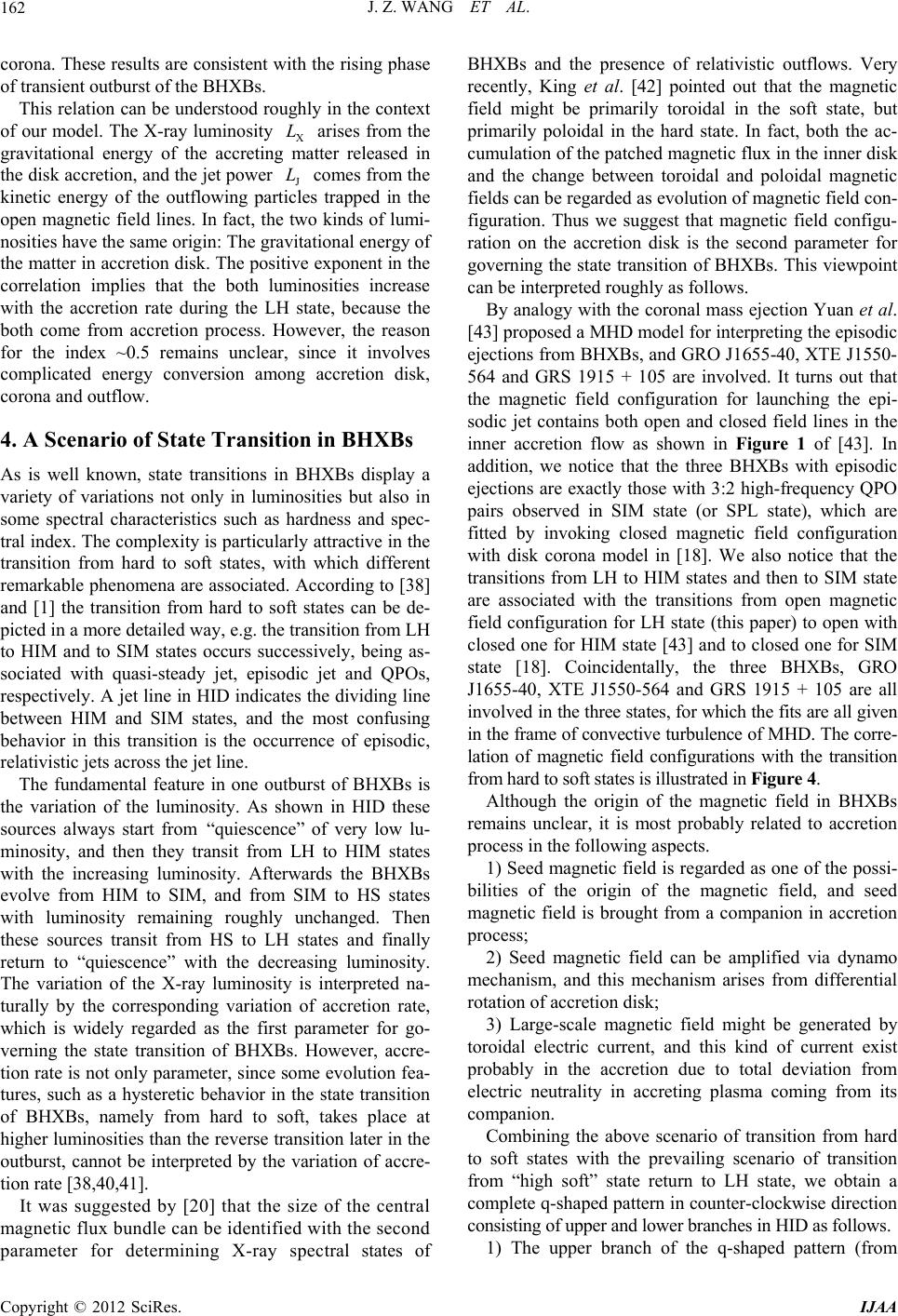 J. Z. WANG ET AL. Copyright © 2012 SciRes. IJAA 162 corona. These results are consistent with the rising phase of transient outburst of the BHXBs. This relation can be understood roughly in the context of our model. The X-ray luminosity X arises from the gravitational energy of the accreting matter released in the disk accretion, and the jet power J comes from the kinetic energy of the outflowing particles trapped in the open magnetic field lines. In fact, the two kinds of lumi- nosities have the same origin: The gravitational energy of the matter in accretion disk. The positive exponent in the correlation implies that the both luminosities increase with the accretion rate during the LH state, because the both come from accretion process. However, the reason for the index ~0.5 remains unclear, since it involves complicated energy conversion among accretion disk, corona and outflow. L L 4. A Scenario of State Transition in BHXBs As is well known, state transitions in BHXBs display a variety of variations not only in luminosities but also in some spectral characteristics such as hardness and spec- tral index. The complexity is particularly attractive in the transition from hard to soft states, with which different remarkable phenomena are associated. According to [38] and [1] the transition from hard to soft states can be de- picted in a more detailed way, e.g. the transition from LH to HIM and to SIM states occurs successively, being as- sociated with quasi-steady jet, episodic jet and QPOs, respectively. A jet line in HID indicates the dividing line between HIM and SIM states, and the most confusing behavior in this transition is the occurrence of episodic, relativistic jets across the jet line. The fundamental feature in one outburst of BHXBs is the variation of the luminosity. As shown in HID these sources always start from “quiescence” of very low lu- minosity, and then they transit from LH to HIM states with the increasing luminosity. Afterwards the BHXBs evolve from HIM to SIM, and from SIM to HS states with luminosity remaining roughly unchanged. Then these sources transit from HS to LH states and finally return to “quiescence” with the decreasing luminosity. The variation of the X-ray luminosity is interpreted na- turally by the corresponding variation of accretion rate, which is widely regarded as the first parameter for go- verning the state transition of BHXBs. However, accre- tion rate is not only parameter, since some evolution fea- tures, such as a hysteretic behavior in the state transition of BHXBs, namely from hard to soft, takes place at higher luminosities than the reverse transition later in the outburst, cannot be interpreted by the variation of accre- tion rate [38,40,41]. It was suggested by [20] that the size of the central magnetic flux bundle can be identified with the second parameter for determining X-ray spectral states of BHXBs and the presence of relativistic outflows. Very recently, King et al. [42] pointed out that the magnetic field might be primarily toroidal in the soft state, but primarily poloidal in the hard state. In fact, both the ac- cumulation of the patched magnetic flux in the inner disk and the change between toroidal and poloidal magnetic fields can be regarded as evolution of magnetic field con- figuration. Thus we suggest that magnetic field configu- ration on the accretion disk is the second parameter for governing the state transition of BHXBs. This viewpoint can be interpreted roughly as follows. By analogy with the coronal mass ejection Yuan et al. [43] proposed a MHD model for interpreting the episodic ejections from BHXBs, and GRO J1655-40, XTE J1550- 564 and GRS 1915 + 105 are involved. It turns out that the magnetic field configuration for launching the epi- sodic jet contains both open and closed field lines in the inner accretion flow as shown in Figure 1 of [43]. In addition, we notice that the three BHXBs with episodic ejections are exactly those with 3:2 high-frequency QPO pairs observed in SIM state (or SPL state), which are fitted by invoking closed magnetic field configuration with disk corona model in [18]. We also notice that the transitions from LH to HIM states and then to SIM state are associated with the transitions from open magnetic field configuration for LH state (this paper) to open with closed one for HIM state [43] and to closed one for SIM state [18]. Coincidentally, the three BHXBs, GRO J1655-40, XTE J1550-564 and GRS 1915 + 105 are all involved in the three states, for which the fits are all given in the frame of convective turbulence of MHD. The corre- lation of magnetic field configurations with the transition from hard to soft states is illustrated in Figure 4. Although the origin of the magnetic field in BHXBs remains unclear, it is most probably related to accretion process in the following aspects. 1) Seed magnetic field is regarded as one of the possi- bilities of the origin of the magnetic field, and seed magnetic field is brought from a companion in accretion process; 2) Seed magnetic field can be amplified via dynamo mechanism, and this mechanism arises from differential rotation of accretion disk; 3) Large-scale magnetic field might be generated by toroidal electric current, and this kind of current exist probably in the accretion due to total deviation from electric neutrality in accreting plasma coming from its companion. Combining the above scenario of transition from hard to soft states with the prevailing scenario of transition from “high soft” state return to LH state, we obtain a complete q-shaped pattern in counter-clockwise direction consisting of upper and lower branches in HID as follows. 1) The upper branch of the q-shaped pattern (from 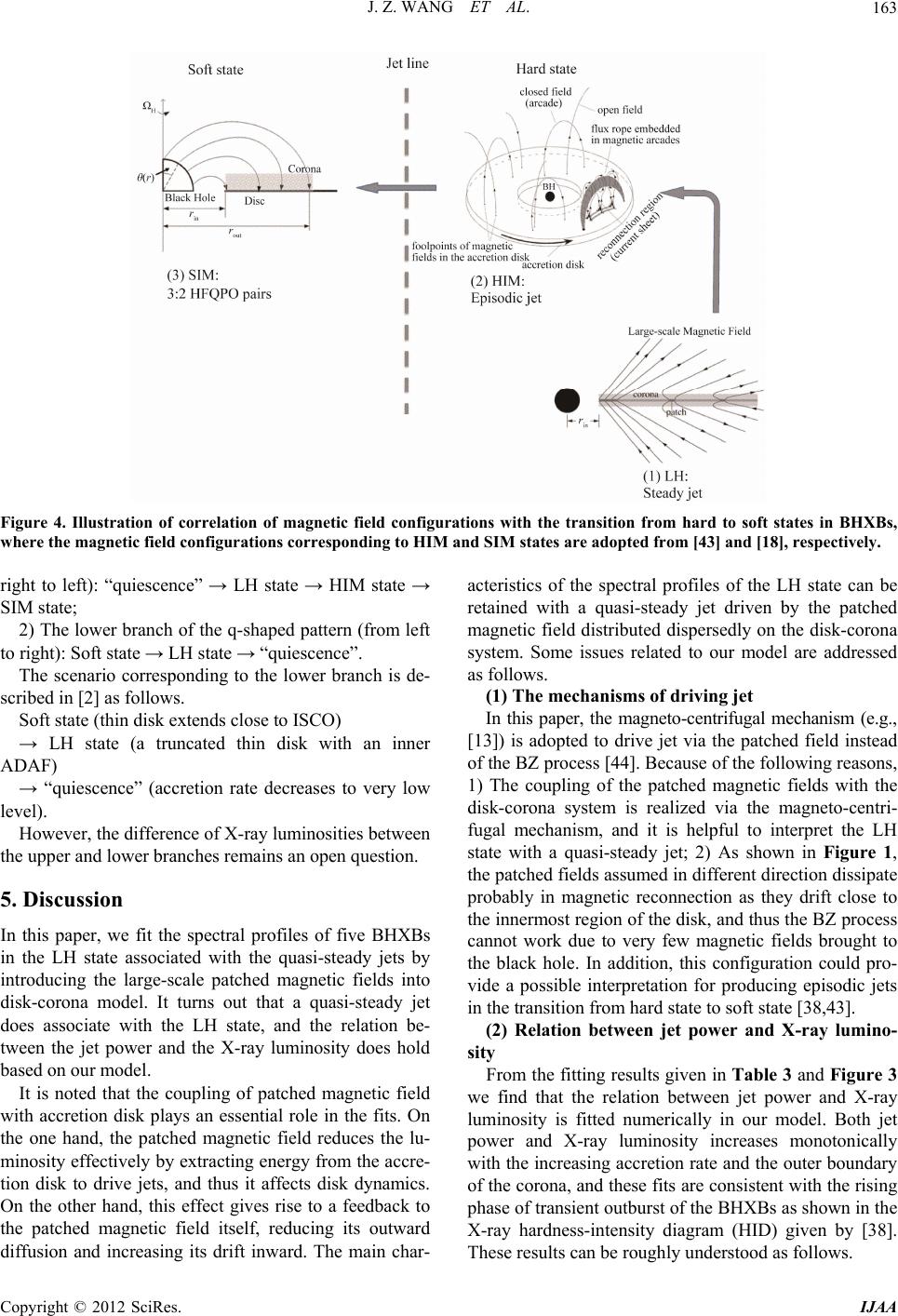 J. Z. WANG ET AL. 163 Figure 4. Illustration of correlation of magnetic field configurations with the transition from hard to soft states in BHXBs, where the magnetic field configurations corresponding to HIM and SIM states are adopted from [43] and [18], respectively. right to left): “quiescence” → LH state → HIM state → SIM state; 2) The lower branch of the q-shaped pattern (from left to right): Soft state → LH state → “quiescence”. The scenario corresponding to the lower branch is de- scribed in [2] as follows. Soft state (thin disk extends close to ISCO) → LH state (a truncated thin disk with an inner ADAF) → “quiescence” (accretion rate decreases to very low level). However, the difference of X-ray luminosities between the upper and lower branches remains an open question. 5. Discussion In this paper, we fit the spectral profiles of five BHXBs in the LH state associated with the quasi-steady jets by introducing the large-scale patched magnetic fields into disk-corona model. It turns out that a quasi-steady jet does associate with the LH state, and the relation be- tween the jet power and the X-ray luminosity does hold based on our model. It is noted that the coupling of patched magnetic field with accretion disk plays an essential role in the fits. On the one hand, the patched magnetic field reduces the lu- minosity effectively by extracting energy from the accre- tion disk to drive jets, and thus it affects disk dynamics. On the other hand, this effect gives rise to a feedback to the patched magnetic field itself, reducing its outward diffusion and increasing its drift inward. The main char- acteristics of the spectral profiles of the LH state can be retained with a quasi-steady jet driven by the patched magnetic field distributed dispersedly on the disk-corona system. Some issues related to our model are addressed as follows. (1) The mechanisms of driving jet In this paper, the magneto-centrifugal mechanism (e.g., [13]) is adopted to drive jet via the patched field instead of the BZ process [44]. Because of the following reasons, 1) The coupling of the patched magnetic fields with the disk-corona system is realized via the magneto-centri- fugal mechanism, and it is helpful to interpret the LH state with a quasi-steady jet; 2) As shown in Figure 1, the patched fields assumed in different direction dissipate probably in magnetic reconnection as they drift close to the innermost region of the disk, and thus the BZ process cannot work due to very few magnetic fields brought to the black hole. In addition, this configuration could pro- vide a possible interpretation for producing episodic jets in the transition from hard state to soft state [38,43]. (2) Relation between jet power and X-ray lumino- sity From the fitting results given in Table 3 and Figure 3 we find that the relation between jet power and X-ray luminosity is fitted numerically in our model. Both jet power and X-ray luminosity increases monotonically with the increasing accretion rate and the outer boundary of the corona, and these fits are consistent with the rising phase of transient outburst of the BHXBs as shown in the X-ray hardness-intensity diagram (HID) given by [38]. These results can be roughly understood as follows. Copyright © 2012 SciRes. IJAA 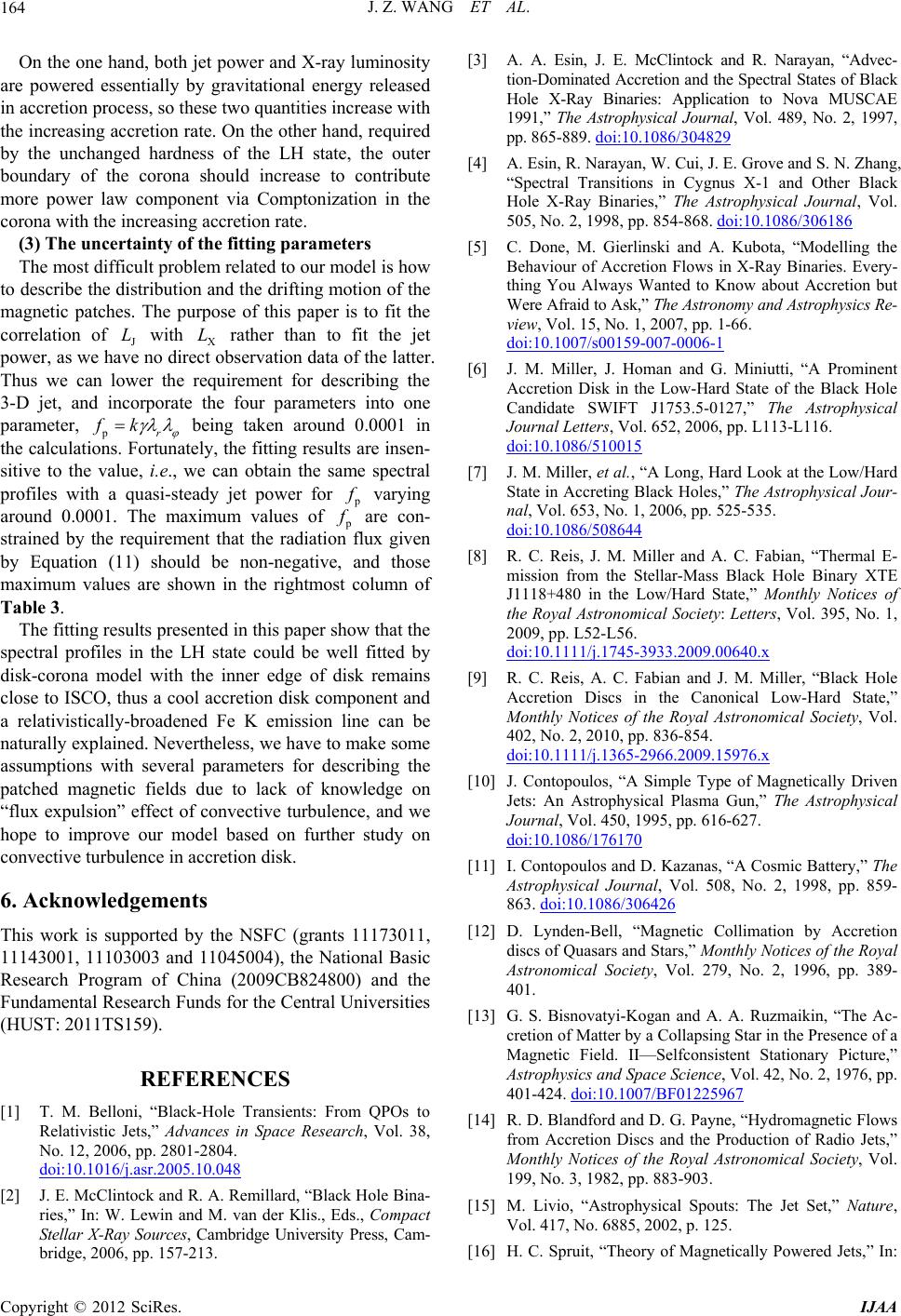 J. Z. WANG ET AL. 164 On the one hand, both jet power and X-ray luminosity are powered essentially by gravitational energy released in accretion process, so these two quantities increase with the increasing accretion rate. On the other hand, required by the unchanged hardness of the LH state, the outer boundary of the corona should increase to contribute more power law component via Comptonization in the corona with the increasing accretion rate. (3) The uncertainty of the fitting parameters The most difficult problem related to our model is how to describe the distribution and the drifting motion of the magnetic patches. The purpose of this paper is to fit the correlation of J with X rather than to fit the jet power, as we have no direct observation data of the latter. Thus we can lower the requirement for describing the 3-D jet, and incorporate the four parameters into one parameter, pr L fk L being taken around 0.0001 in the calculations. Fortunately, the fitting results are insen- sitive to the value, i.e., we can obtain the same spectral profiles with a quasi-steady jet power for varying around 0.0001. The maximum values of are con- strained by the requirement that the radiation flux given by Equation (11) should be non-negative, and those maximum values are shown in the rightmost column of Table 3. The fitting results presented in this paper show that the spectral profiles in the LH state could be well fitted by disk-corona model with the inner edge of disk remains close to ISCO, thus a cool accretion disk component and a relativistically-broadened Fe K emission line can be naturally explained. Nevertheless, we have to make some assumptions with several parameters for describing the patched magnetic fields due to lack of knowledge on “flux expulsion” effect of convective turbulence, and we hope to improve our model based on further study on convective turbulence in accretion disk. 6. Acknowledgements This work is supported by the NSFC (grants 11173011, 11143001, 11103003 and 11045004), the National Basic Research Program of China (2009CB824800) and the Fundamental Research Funds for the Central Universities (HUST: 2011TS159). REFERENCES [1] T. M. Belloni, “Black-Hole Transients: From QPOs to Relativistic Jets,” Advances in Space Research, Vol. 38, No. 12, 2006, pp. 2801-2804. doi:10.1016/j.asr.2005.10.048 [2] J. E. McClintock and R. A. Remillard, “Black Hole Bina- ries,” In: W. Lewin and M. van der Klis., Eds., Compact Stellar X-Ray Sources, Cambridge University Press, Cam- bridge, 2006, pp. 157-213. [3] A. A. Esin, J. E. McClintock and R. Narayan, “Advec- tion-Dominated Accretion and the Spectral States of Black Hole X-Ray Binaries: Application to Nova MUSCAE 1991,” The Astrophysical Journal, Vol. 489, No. 2, 1997, pp. 865-889. doi:10.1086/304829 [4] A. Esin, R. Narayan, W. Cui, J. E. Grove and S. N. Zhang, “Spectral Transitions in Cygnus X-1 and Other Black Hole X-Ray Binaries,” The Astrophysical Journal, Vol. 505, No. 2, 1998, pp. 854-868. doi:10.1086/306186 [5] C. Done, M. Gierlinski and A. Kubota, “Modelling the Behaviour of Accretion Flows in X-Ray Binaries. Every- thing You Always Wanted to Know about Accretion but Were Afraid to Ask,” The Astronomy and Astrophysics Re- view, Vol. 15, No. 1, 2007, pp. 1-66. doi:10.1007/s00159-007-0006-1 [6] J. M. Miller, J. Homan and G. Miniutti, “A Prominent Accretion Disk in the Low-Hard State of the Black Hole Candidate SWIFT J1753.5-0127,” The Astrophysical Journal Letters, Vol. 652, 2006, pp. L113-L116. doi:10.1086/510015 [7] J. M. Miller, et al., “A Long, Hard Look at the Low/Hard State in Accreting Black Holes,” The Astrophysical Jour- nal, Vol. 653, No. 1, 2006, pp. 525-535. doi:10.1086/508644 [8] R. C. Reis, J. M. Miller and A. C. Fabian, “Thermal E- mission from the Stellar-Mass Black Hole Binary XTE J1118+480 in the Low/Hard State,” Monthly Notices of the Royal Astronomical Society: Letters, Vol. 395, No. 1, 2009, pp. L52-L56. doi:10.1111/j.1745-3933.2009.00640.x [9] R. C. Reis, A. C. Fabian and J. M. Miller, “Black Hole Accretion Discs in the Canonical Low-Hard State,” Monthly Notices of the Royal Astronomical Society, Vol. 402, No. 2, 2010, pp. 836-854. doi:10.1111/j.1365-2966.2009.15976.x [10] J. Contopoulos, “A Simple Type of Magnetically Driven Jets: An Astrophysical Plasma Gun,” The Astrophysical Journal, Vol. 450, 1995, pp. 616-627. doi:10.1086/176170 [11] I. Contopoulos and D. Kazanas, “A Cosmic Battery,” The Astrophysical Journal, Vol. 508, No. 2, 1998, pp. 859- 863. doi:10.1086/306426 [12] D. Lynden-Bell, “Magnetic Collimation by Accretion discs of Quasars and Stars,” Monthly Notices of the Royal Astronomical Society, Vol. 279, No. 2, 1996, pp. 389- 401. [13] G. S. Bisnovatyi-Kogan and A. A. Ruzmaikin, “The Ac- cretion of Matter by a Collapsing Star in the Presence of a Magnetic Field. II—Selfconsistent Stationary Picture,” Astrophysics and Space Science, Vol. 42, No. 2, 1976, pp. 401-424. doi:10.1007/BF01225967 [14] R. D. Blandford and D. G. Payne, “Hydromagnetic Flows from Accretion Discs and the Production of Radio Jets,” Monthly Notices of the Royal Astronomical Society, Vol. 199, No. 3, 1982, pp. 883-903. [15] M. Livio, “Astrophysical Spouts: The Jet Set,” Nature, Vol. 417, No. 6885, 2002, p. 125. [16] H. C. Spruit, “Theory of Magnetically Powered Jets,” In: Copyright © 2012 SciRes. IJAA 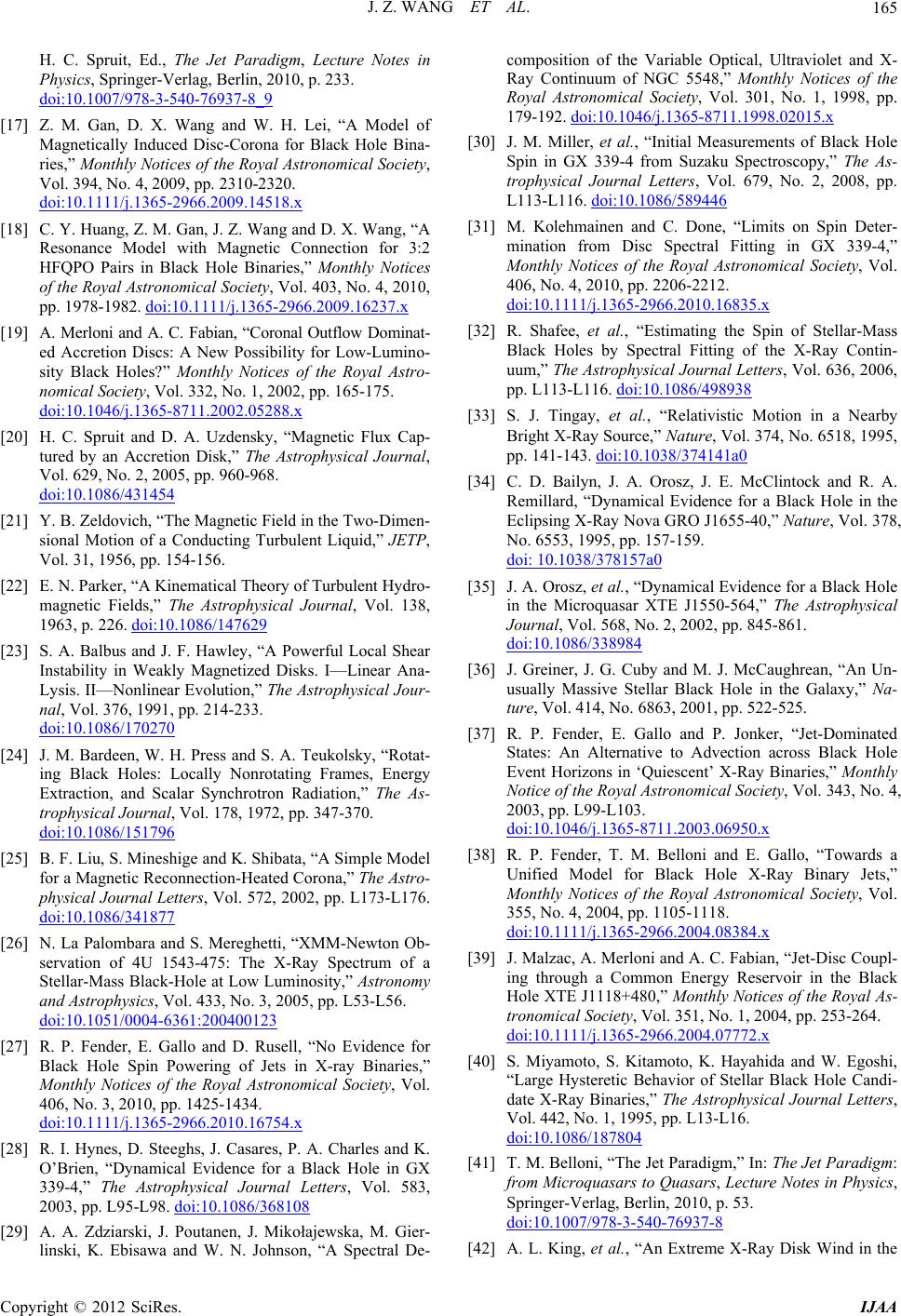 J. Z. WANG ET AL. 165 H. C. Spruit, Ed., The Jet Paradigm, Lecture Notes in Physics, Springer-Verlag, Berlin, 2010, p. 233. doi:10.1007/978-3-540-76937-8_9 [17] Z. M. Gan, D. X. Wang and W. H. Lei, “A Model of Magnetically Induced Disc-Corona for Black Hole Bina- ries,” Monthly Notices of the Royal Astronomical Society, Vol. 394, No. 4, 2009, pp. 2310-2320. doi:10.1111/j.1365-2966.2009.14518.x [18] C. Y. Huang, Z. M. Gan, J. Z. Wang and D. X. Wang, “A Resonance Model with Magnetic Connection for 3:2 HFQPO Pairs in Black Hole Binaries,” Monthly Notices of the Royal Astronomical Society, Vol. 403, No. 4, 2010, pp. 1978-1982. doi:10.1111/j.1365-2966.2009.16237.x [19] A. Merloni and A. C. Fabian, “Coronal Outflow Dominat- ed Accretion Discs: A New Possibility for Low-Lumino- sity Black Holes?” Monthly Notices of the Royal Astro- nomical Society, Vol. 332, No. 1, 2002, pp. 165-175. doi:10.1046/j.1365-8711.2002.05288.x [20] H. C. Spruit and D. A. Uzdensky, “Magnetic Flux Cap- tured by an Accretion Disk,” The Astrophysical Journal, Vol. 629, No. 2, 2005, pp. 960-968. doi:10.1086/431454 [21] Y. B. Zeldovich, “The Magnetic Field in the Two-Dimen- sional Motion of a Conducting Turbulent Liquid,” JETP, Vol. 31, 1956, pp. 154-156. [22] E. N. Parker, “A Kinematical Theory of Turbulent Hydro- magnetic Fields,” The Astrophysical Journal, Vol. 138, 1963, p. 226. doi:10.1086/147629 [23] S. A. Balbus and J. F. Hawley, “A Powerful Local Shear Instability in Weakly Magnetized Disks. I—Linear Ana- Lysis. II—Nonlinear Evolution,” The Astrophysical Jour- nal, Vol. 376, 1991, pp. 214-233. doi:10.1086/170270 [24] J. M. Bardeen, W. H. Press and S. A. Teukolsky, “Rotat- ing Black Holes: Locally Nonrotating Frames, Energy Extraction, and Scalar Synchrotron Radiation,” The As- trophysical Journal, Vol. 178, 1972, pp. 347-370. doi:10.1086/151796 [25] B. F. Liu, S. Mineshige and K. Shibata, “A Simple Model for a Magnetic Reconnection-Heated Corona,” The Astro- physical Journal Letters, Vol. 572, 2002, pp. L173-L176. doi:10.1086/341877 [26] N. La Palombara and S. Mereghetti, “XMM-Newton Ob- servation of 4U 1543-475: The X-Ray Spectrum of a Stellar-Mass Black-Hole at Low Luminosity,” Astronomy and Astrophysics, Vol. 433, No. 3, 2005, pp. L53-L56. doi:10.1051/0004-6361:200400123 [27] R. P. Fender, E. Gallo and D. Rusell, “No Evidence for Black Hole Spin Powering of Jets in X-ray Binaries,” Monthly Notices of the Royal Astronomical Society, Vol. 406, No. 3, 2010, pp. 1425-1434. doi:10.1111/j.1365-2966.2010.16754.x [28] R. I. Hynes, D. Steeghs, J. Casares, P. A. Charles and K. O’Brien, “Dynamical Evidence for a Black Hole in GX 339-4,” The Astrophysical Journal Letters, Vol. 583, 2003, pp. L95-L98. doi:10.1086/368108 [29] A. A. Zdziarski, J. Poutanen, J. Mikołajewska, M. Gier- linski, K. Ebisawa and W. N. Johnson, “A Spectral De- composition of the Variable Optical, Ultraviolet and X- Ray Continuum of NGC 5548,” Monthly Notices of the Royal Astronomical Society, Vol. 301, No. 1, 1998, pp. 179-192. doi:10.1046/j.1365-8711.1998.02015.x [30] J. M. Miller, et al., “Initial Measurements of Black Hole Spin in GX 339-4 from Suzaku Spectroscopy,” The As- trophysical Journal Letters, Vol. 679, No. 2, 2008, pp. L113-L116. doi:10.1086/589446 [31] M. Kolehmainen and C. Done, “Limits on Spin Deter- mination from Disc Spectral Fitting in GX 339-4,” Monthly Notices of the Royal Astronomical Society, Vol. 406, No. 4, 2010, pp. 2206-2212. doi:10.1111/j.1365-2966.2010.16835.x [32] R. Shafee, et al., “Estimating the Spin of Stellar-Mass Black Holes by Spectral Fitting of the X-Ray Contin- uum,” The Astrophysical Journal Letters, Vol. 636, 2006, pp. L113-L116. doi:10.1086/498938 [33] S. J. Tingay, et al., “Relativistic Motion in a Nearby Bright X-Ray Source,” Nature, Vol. 374, No. 6518, 1995, pp. 141-143. doi:10.1038/374141a0 [34] C. D. Bailyn, J. A. Orosz, J. E. McClintock and R. A. Remillard, “Dynamical Evidence for a Black Hole in the Eclipsing X-Ray Nova GRO J1655-40,” Nature, Vol. 378, No. 6553, 1995, pp. 157-159. doi: 10.1038/378157a0 [35] J. A. Orosz, et al., “Dynamical Evidence for a Black Hole in the Microquasar XTE J1550-564,” The Astrophysical Journal, Vol. 568, No. 2, 2002, pp. 845-861. doi:10.1086/338984 [36] J. Greiner, J. G. Cuby and M. J. McCaughrean, “An Un- usually Massive Stellar Black Hole in the Galaxy,” Na- ture, Vol. 414, No. 6863, 2001, pp. 522-525. [37] R. P. Fender, E. Gallo and P. Jonker, “Jet-Dominated States: An Alternative to Advection across Black Hole Event Horizons in ‘Quiescent’ X-Ray Binaries,” Monthly Notice of the Royal Astronomical Society, Vol. 343, No. 4, 2003, pp. L99-L103. doi:10.1046/j.1365-8711.2003.06950.x [38] R. P. Fender, T. M. Belloni and E. Gallo, “Towards a Unified Model for Black Hole X-Ray Binary Jets,” Monthly Notices of the Royal Astronomical Society, Vol. 355, No. 4, 2004, pp. 1105-1118. doi:10.1111/j.1365-2966.2004.08384.x [39] J. Malzac, A. Merloni and A. C. Fabian, “Jet-Disc Coupl- ing through a Common Energy Reservoir in the Black Hole XTE J1118+480,” Monthly Notices of the Royal As- tronomical Society, Vol. 351, No. 1, 2004, pp. 253-264. doi:10.1111/j.1365-2966.2004.07772.x [40] S. Miyamoto, S. Kitamoto, K. Hayahida and W. Egoshi, “Large Hysteretic Behavior of Stellar Black Hole Candi- date X-Ray Binaries,” The Astrophysical Journal Letters, Vol. 442, No. 1, 1995, pp. L13-L16. doi:10.1086/187804 [41] T. M. Belloni, “The Jet Paradigm,” In: The Jet Paradigm: from Microquasars to Quasars, Lecture Notes in Physics, Springer-Verlag, Berlin, 2010, p. 53. doi:10.1007/978-3-540-76937-8 [42] A. L. King, et al., “An Extreme X-Ray Disk Wind in the Copyright © 2012 SciRes. IJAA  J. Z. WANG ET AL. Copyright © 2012 SciRes. IJAA 166 Black Hole Candidate IGR J17091-3624,” The Astro- physical Journal Letters, Vol. 746, 2012, p. L20. doi:10.1088/2041-8205/746/2/L20 [43] F. Yuan, J. Lin, K. W. Wu and C. H. Luis, “A Magneto- hydrodynamical Model for the Formation of Episodic Jets,” Monthly Notices of the Royal Astronomical Society, Vol. 395, No. 4, 2009, pp. 2183-2188. doi:10.1111/j.1365-2966.2009.14673.x [44] R. D. Blandford and R. L. Znajek, “Electromagnetic Ex- traction of Energy from Kerr Black Holes,” Monthly No- tices of the Royal Astronomical Society, Vol. 179, 1977, pp. 433-456.
|